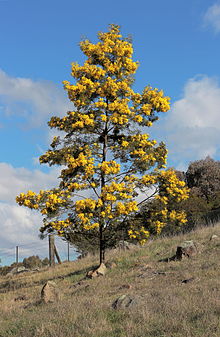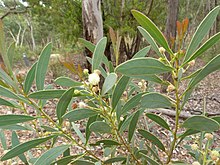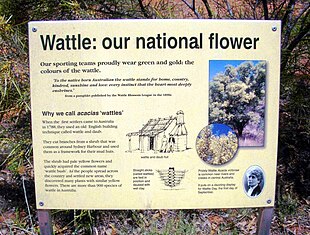Acacia
| Acacia | |
|---|---|

| |
| Acacia baileyana near Canberra, Australia | |
| Scientific classification | |
| Kingdom: | Plantae |
| Clade: | Tracheophytes |
| Clade: | Angiosperms |
| Clade: | Eudicots |
| Clade: | Rosids |
| Order: | Fabales |
| Family: | Fabaceae |
| Subfamily: | Caesalpinioideae |
| Clade: | Mimosoid clade |
| Genus: | Acacia Mill.[1] |
| Type species | |
| Acacia penninervis | |
| Species | |
| Synonyms | |



Acacia, commonly known as wattles or acacias, is a genus of about 1084 species of shrubs and trees in the subfamily
A number of species of Acacia have been introduced to various parts of the world, and two million hectares of commercial plantations have been established.[5]
Description
Plants in the genus Acacia are shrubs or trees with
Taxonomy
The genus was first validly named in 1754 by
History
Genus Acacia was considered to contain some 1352 species leading to 1986. That year
In the early 2000s, it had become evident that the genus as it stood was not monophyletic and that several divergent lineages needed to be placed in separate genera. It turned out that one lineage comprising over 900 species mainly native to Australia, New Guinea, and Indonesia was not closely related to the much smaller group of African lineage that contained A. nilotica – the type species. This meant that the Australasian lineage (by far the most prolific in number of species) would need to be renamed. Pedley's proposed name of Racosperma for this group had received little acclaim in the botanical community. Australian botanists proposed a less disruptive solution, setting a different type species for Acacia (A. penninervis) and allowing this largest number of species to remain in Acacia, resulting in the two pan-tropical lineages being renamed Vachellia and Senegalia, and the two endemic American lineages renamed Acaciella and Mariosousa.[18]
In 2003, Anthony Orchard and Bruce Maslin filed a proposal to conserve the name Acacia with a different type, in order to retain the Australasian group of species in the genus Acacia.[16] Following a controversial decision to choose a new type for Acacia in 2005, the Australian component of Acacia s.l. now retains the name Acacia.[19][20] At the 2011 International Botanical Congress held in Melbourne, Australia, the decision to use the name Acacia, rather than the proposed Racosperma for this genus, was upheld.[21][22] Other Acacia s.l. taxa continue to be called Acacia by those who choose to consider the entire group as one genus.[22]
Australian species of the genus
Etymology
The origin of "wattle" may be an Old Teutonic word meaning "to weave".[25] From around 700 CE, watul was used in Old English to refer to the interwoven branches and sticks which formed fences, walls and roofs. Since about 1810 it refers to the Australian legumes that provide these branches.[25]
Species
There are about 1080 species of Acacia, mostly native to Australia.[9]
Fossil record
An Acacia-like 14 centimetres (5+1⁄2 inches) long
Distribution and habitat
Species of Acacia occurs in all Australian states and territories, and on its nearby islands. About 20 species occur naturally outside Australia and 7 of these also occur in Australia. One species (Acacia koa) is native to Hawaii[30] and one (Acacia heterophylla) is native to Mauritius and Réunion in the Indian Ocean.[9][31]
They are present in all terrestrial habitats, including alpine settings, rainforests, woodlands, grasslands, coastal dunes and deserts.[11] In drier woodlands or forests they are an important component of the understory. Elsewhere they may be dominant, as in the Brigalow Belt, Myall woodlands and the eremaean Mulga woodlands.[11]
In Australia, Acacia forest is the second most common forest type after eucalypt forest, covering 980,000 square kilometres (378,380 sq mi) or 8% of total forest area. Acacia is also the nation's largest genus of flowering plants with almost 1,000 species found.[32]
Ecology
Acacia is a common food source and host plant for butterflies of the genus Jalmenus. The imperial hairstreak, Jalmenus evagoras, feeds on at least 25 acacia species.[33] Many reptiles feed on the sap, such as the native house gecko in Australia.[34] The sap is also consumed by bugs (Hemiptera), such as Hackerobrachys viridiventris[35] and Sextius virescens.[36]
Toxicity
Some species of acacia contain
Uses

The seed pods, flowers, and young leaves are generally edible either raw or cooked.[38]
Aboriginal Australians have traditionally harvested the seeds of some species, to be ground into flour and eaten as a paste or baked into a cake. Wattleseeds contain as much as 25% more protein than common cereals, and they store well for long periods due to the hard seed coats.[39] In addition to using the edible seed and gum, the people employed the timber for implements, weapons, fuel and musical instruments.[11] A number of species, most notably Acacia mangium (hickory wattle), Acacia mearnsii (black wattle) and Acacia saligna (coojong), are economically important and are widely planted globally for wood products, tannin, firewood and fodder.[19] Acacia melanoxylon (blackwood) and Acacia aneura (mulga) supply some of the most attractive timbers in the genus.[11] Black wattle bark supported the tanning industries of several countries, and may supply tannins for production of waterproof adhesives.[11]
In
Wattle bark collected in Australia in the 19th century was exported to Europe where it was used in the tanning process. One ton of wattle or mimosa bark contained about 68 kilograms (150 pounds) of pure tannin.[42]
Cultivation
Some species of acacia – notably Acacia baileyana, Acacia dealbata and Acacia pravissima – are cultivated as ornamental garden plants. The 1889 publication Useful Native Plants of Australia describes various uses for eating.[43]
References
- ^ a b c "Acacia". Plants of the World Online. Retrieved 9 December 2023.
- ^ "Report of the General Committee". Taxon. 55 (3): 798. 2006.
- ^ "Vachellia nilotica (L.) P.J.H.Hurter & Mabb. | Plants of the World Online | Kew Science". Plants of the World Online. Retrieved 2024-02-27.
- ^ Bauhin, Caspar; Bauhin, Caspar (1623). Pinax Theatri botanici Caspari Bauhini : ... sive Index in Theophrasti, Dioscoridis, Plinii et botanicorum qui à seculo scripserunt opera: plantarum circiter sex millium ab ipsis exhibitarum nomina cum earundem synonymiis & differentiis methodicè secundùm earum & genera & species proponens. Opus XL. annorum hactenus non editum summoperè expetitum & ad auctores intelligendos plurimùm faciens ... Basileae Helvet: sumptibus et typis Ludovici Regis. p. 391.
- doi:10.1071/SB01038.
- ^ Kodela, Phillip G.; Harden, Gwen J. "Genus Acacia". Royal Botanic Garden, Sydney. Retrieved 9 December 2023.
- ^ Entwisle, Timothy J.; Maslin, Bruce R.; Cowan, Richard S.; Court, Arthur B.; Walsh, Neville G. "Acacia". Royal Botanic Gardens Victoria. Retrieved 9 December 2023.
- ^ "Acacia". State Herbarium of South Australia. Retrieved 9 December 2023.
- ^ a b c Kodela, Phillip G.; Maslin, Bruce R. Kodela, Philip G. (ed.). "Acacia". Canberra, Australia: Flora of Australia. Australian Biological Resources Study, Department of Climate Change, Energy, the Environment and Water. Retrieved 9 December 2023.
- ^ S2CID 199562144. Retrieved 22 November 2015.
- ^ ISBN 9780643067172.
- ^ Miller, P. (1754). The Gardeners Dictionary, abbridged. Vol. 1 (4 ed.). p. [25]. Only the name of the genus, Miller did not validly publish names of species in this work as he did not consistently use binomial names.
- ^ Martius, C. F. P. von (1829). Hortus regius Monacensis. p. 188.
- ^ Martius, C. F. P. von (1835). Hortus regius Monacensis seminifer. Vol. 1835. p. 4. Archived from the original on 2022-01-10. Retrieved 2020-06-19.
- PMID 32362685.
- ^ JSTOR 3647418.
- JSTOR 41738994.
- hdl:10566/3454.
- ^ . Retrieved 15 November 2015.
- . Retrieved 19 November 2015.
- ^ "The Acacia debate" (PDF). IBC2011 Congress News. Retrieved May 5, 2016.
- ^ hdl:2263/17733.
- S2CID 85416700.
- S2CID 85910836.
- ^ ISBN 9780203491881.
- ISBN 0-565-09176-X.
- ISBN 0947643400
- ISBN 0947643400.
- ISBN 0730101541.
- ^ "Acacia koa". Plants of the World Online. Retrieved 10 December 2023.
- ^ "Acacia heterophylla". Plants of the World Online. Retrieved 10 December 2023.
- Commonwealth of Australia. 6 February 2017. Retrieved 19 April 2017.
- )
- ^ Limited, Alamy. "Flat-headed House Gecko (Hemidactylus platycephalus) adult feeding on solidified sap of acacia tree Kafue N.P. Zambia September Stock Photo – Alamy". www.alamy.com. Retrieved 2022-03-25.
- ^ Constant, J. (2006). "Revision of the Eurybrachidae (VII). The Australian genera Hackerobrachys and Fletcherobrachys (Hemiptera: Fulgoromorpha: Eurybrachidae)". Bulletin de l'Institut Royal des Sciences Naturelles de Belgique, Entomologie. 76: 31–40.
- ^ "Acacia Horned Treehopper – Sextius virescens". www.brisbaneinsects.com. Retrieved 2023-02-12.
- PMID 28674607.
- )
- ^ Tan, Ria. "Acacia auriculiformis, Black Wattle". Naturia. Archived from the original on 5 May 2015. Retrieved 17 November 2015.
- S2CID 84167231.
- ^ Tatarski, Michael (20 May 2021). "'Drastic forest development': Vietnam to plant 1 billion trees – but how?". Mongabay Environmental News. Retrieved 5 November 2023.
- ^ The National Cyclopaedia of Useful Knowledge Vol II, (1847) Charles Knight, London, England, p. 873.
- ^ Maiden, J. H. (1889). Useful native plants of Australia : Including Tasmania. Turner and Henderson, Sydney.
Other sources
- Pedley, L. (2002). "A conspectus of Acacia subgen. Acacia in Australia". Austrobaileya 6(2): 177–186.
- Pedley, L. (2003). A synopsis of Racosperma C.Mart". Austrobaileya 6(3): 445–496.
